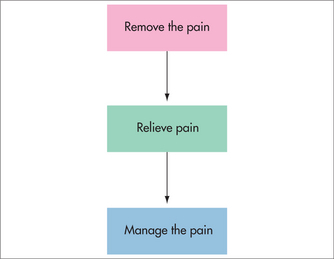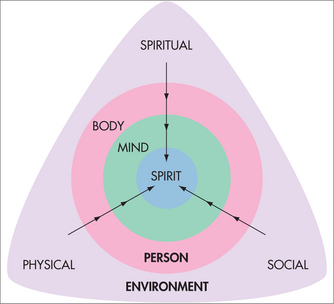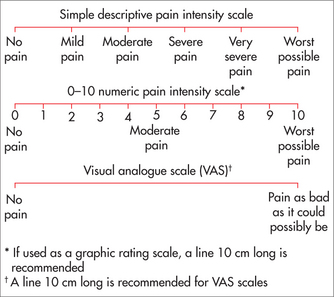chapter 38 Pain management
INTRODUCTION AND OVERVIEW
One of the most common reasons for people presenting to a healthcare practitioner is the presence of pain. Many people in our community also experience persistent pain, with most studies showing that around 20% of the population suffer from some type of chronic pain problem.1 In the past 25 years, there have been some major shifts in our thinking regarding the treatment of pain. One is an increased understanding of the biological changes that occur in the presence of pain. These include neuroplastic changes within the central nervous system that need to be addressed as part of successful pain management. The other has been the increasing prominence of a holistic approach to assessment and treatment. This has come from two directions. Pain practitioners have increasingly recognised the limitations of a purely biomedical approach to pain management. Many patients have also demonstrated dissatisfaction with this type of approach. The large number of people using complementary and alternative treatments as part of their pain management indicates the limitations of currently available treatments as well as a desire for a more holistic approach.
BOX 38.4 Complex regional pain syndrome
TYPES OF PAIN
Pain is often divided clinically into acute, cancer and chronic non-cancer pain. This division reflects differences in treatment approach, although to some extent each of these aims applies to any type of pain (Fig 38.1). For acute pain, the emphasis is generally on removing the pain by identifying the cause and providing pain relief until healing occurs. In cancer pain, there is a stronger focus on pain relief, as removal of the cause of pain may be difficult. The emphasis in chronic non-cancer pain is generally on pain relief, with a stronger focus on pain management. In many chronic pain conditions, the specific cause of the pain cannot be identified with certainty, or may not be treatable. Using an acute pain approach in people with chronic non-cancer pain, with its ongoing search for a cause and removal of the pain, can be counter-productive, preventing people from accepting and dealing with their pain, and prolonging and even exacerbating their disability.
PAIN PATHOLOGY
BIOLOGICAL
Pain is a primary indicator of tissue pathology. From a biological perspective, pain can be divided into two pain types, based on underlying mechanisms (Box 38.1). Nociceptive pain is pain arising from pathology in somatic and visceral structures, such as bone fractures, appendicitis and renal calculi. Neuropathic pain is pain arising from pathology in neural structures, including the peripheral nervous system (e.g. diabetic neuropathic pain and postherpetic neuralgia) and the central nervous system (e.g. spinal cord injury pain and central post-stroke pain). Pain is initiated by damage or potential damage to somatic, visceral or neural tissues. However, a number of secondary changes including sensitisation at the periphery (peripheral sensitisation) and in the central nervous system (central sensitisation) are associated with trauma and the transmission of pain signals.2 These secondary processes further amplify the pain experience. This means that the treatment of pain often needs to address these secondary changes as well as the underlying cause or generator of the pain.
PSYCHOLOGICAL
Psychological processes are also extremely important in the experience of pain.3 Although many texts refer to psychogenic pain, pain caused by psychological factors is rare and the term may be unhelpful. On the other hand, psychological factors invariably contribute to pain and are a large determinant of the intensity and quality of the pain experience as well as the behaviours that arise as a result of nociceptive and neuropathic stimuli. Mood dysfunction is also a very common consequence of pain. Therefore psychological factors need to be considered and assessed in any person who presents with pain.
Brain imaging studies demonstrate that the perception of pain is not localised to any one brain structure or region, but involves the interaction of many regions that register and modify pain signals, including those involved with attention, mood, emotion, fear and cognition. It is therefore extremely difficult to separate the physical aspect of the pain experience from the suffering that accompanies it. ‘Pain’ can also be experienced vicariously. Empathy, or experiencing another’s pain, has been shown to produce changes in brain activity in the observer that are similar to those in the loved one who is actually experiencing the physical pain—apart from the localisation of any pain inputs.4
Concluding that mind and emotion affect the experience of pain does not imply that the pain is ‘imagined’ but that the relationship between pain perception and the extent of physical tissue damage is very variable. There is strong evidence indicating that the central nervous system is sensitised in many chronic pain states, and it is hypothesised that this sensitisation may be maintained by ‘sustained attention and arousal’.5,6 This means that a person with chronic pain can have accentuated pain in the presence of hypervigilance, preoccupation and neuronal hyperactivity, and may go some way to explaining why emotional state has such a major effect on symptomatology for people with chronic pain syndromes. These physiological and psychological changes provide a link between mind and body and a connection between mood, cognitions and the sensation of pain. From a therapeutic perspective, helping to diminish hypervigilance and reactivity to the experience of pain may explain on a clinical and neurological level the better outcomes of people with chronic pain syndromes who include psychological strategies such as stress management or mindfulness as part of their therapeutic approach. Other reasons why the relaxation response or improving emotional state and mental health may help with chronic pain include reduction in muscle tension, the anti-inflammatory effect of stress reduction, improved responsiveness to endorphins and effects on gamma aminobutyric acid (GABA).7,8
ENVIRONMENTAL INFLUENCES
Pain does not occur in isolation but instead within a context that has a direct bearing on the experience of pain and the person’s response to pain. Environmental influences can be divided into three broad categories: physical, social and spiritual (Fig 38.2). Physical factors that arise from a person’s working or living situation and recreational activities may directly influence or cause pain. For example, for someone in a sedentary occupation with chronic pain, seating posture may have a large bearing on the presence of pain. Social factors such as relationships with family, friends, colleagues, employer or supervisor and cultural background can also strongly influence a person’s experience of pain and their pain behaviour. For example, the way a spouse or partner responds to a person’s pain is a major determinant of the way in which a person with pain will behave. Spiritual factors refer to non-physical, non-personal factors that may influence a person’s experience of pain. From a religious perspective, it is known that a person’s view of God affects their pain. For example, those who view God as punishing or cruel have worse pain outcomes than those who see God as forgiving.9 Many people without any religious affiliation also attribute improvement in their pain to an inherent, ‘supernatural’ ability of certain objects, people or a ‘higher power’. Whether these improvements are real or imagined and whether they are simply due to the physical or psychological properties of the intervention is a matter of ongoing debate and study. Nevertheless, it is difficult to consider a person’s pain from a holistic perspective without recognising and assessing the possible contribution of these factors to their pain experience.
ASSESSMENT OF PAIN
AIMS OF ASSESSMENT
One aim of pain assessment is first to identify the contribution of biological factors to pain, whether nociceptive or neuropathic. The distinction between nociceptive and neuropathic pain is made because the underlying mechanisms giving rise to pain appear to be different, with different pain characteristics and response to treatment (Table 38.1). Nociceptive pain is often dull or aching and, in the case of musculoskeletal pain, related to activity or position. Although not diagnostic, neuropathic pain is suggested by descriptors such as burning, electric and shock-like with pain present in a region of sensory disturbance. Neuropathic pain often occurs in the absence of stimulation, and minor stimulation such as light touch can lead to exaggerated pain (allodynia).
| Nociceptive | Neuropathic | |
|---|---|---|
| Symptoms |
* Dysaesthesia: unpleasant abnormal sensations, e.g. ants crawling under the skin.
It is also important to assess the contribution of psychological, spiritual and environmental factors. Assessment of psychological function includes determining disturbances in mood such as anxiety or depression. It also includes assessing the patient’s cognitions, such as their beliefs regarding the cause of their pain, their expectations and preferences for pain management, fear avoidance behaviours, lack of belief in their ability to function normally (self-efficacy), the level of relief they need in order to return to previous activities and the strategies they use to cope with their pain. Assessment of spiritual factors may be as simple as finding out what activities and relationships are important to the person and how these have been affected by the pain. This may help understand what gives them strength, purpose and meaning in their life. Further enquiries about a person’s beliefs and spiritual practices and how they influence or have been influenced by their experience of pain may also be helpful. Obtaining an environmental history focuses on elucidating any factors in their environment that may be contributing to the pain problem. It includes determining the social context of the patient, such as significant relationships, work, hobbies and activities and how these may be acting to reinforce the pain or hinder recovery.
PAIN HISTORY
A clear history will then provide the basis for further examination and investigations that further refine these preliminary observations. In addition, the history will provide clues regarding other aspects of the person’s presentation. The patient’s manner, tone, emphasis of certain facts, expressions and language will all help to convey important aspects of their expectations, understanding of their problem and emotional state. Although there are many variations on taking pain history, the basic elements consist of:
EXAMINATION
As mentioned above, biological pain generators can be broadly divided into nociceptive or neuropathic. Therefore the physical examination can be broadly divided along these same lines into musculoskeletal (or visceral) and neurological (Box 38.3). Other body systems (e.g. cardiovascular, respiratory and gastrointestinal) may also require examination, depending on the individual’s presentation. For example, a poor cardiovascular history in a person with low back pain should alert the clinician to the possibility of an underlying vascular cause. This would then warrant careful examination of the vascular system and, potentially, further investigation.
BOX 38.3 Physical examination
Examination of pain behaviours
Examination of the painful region








